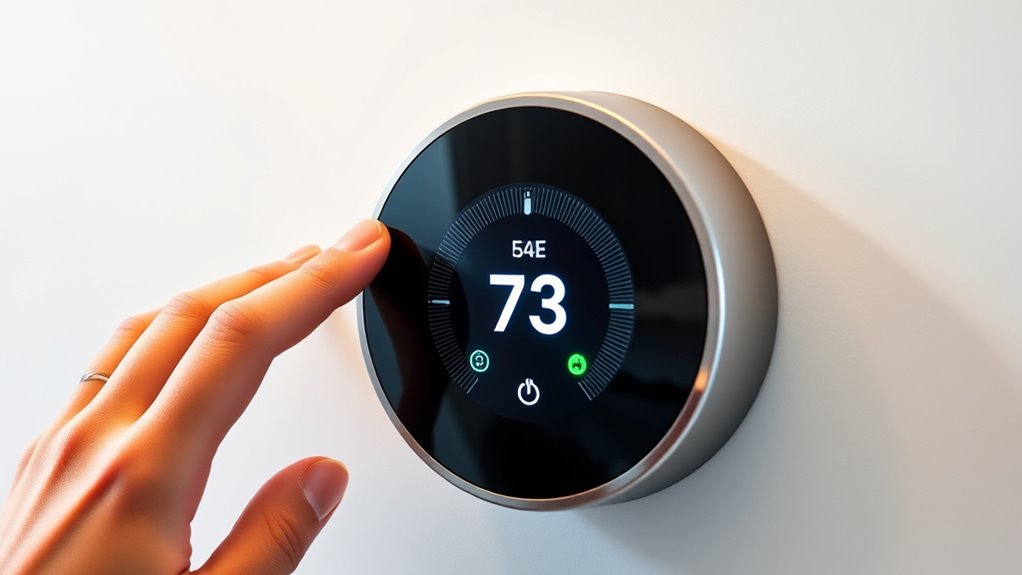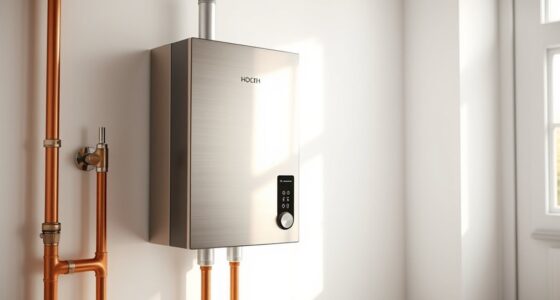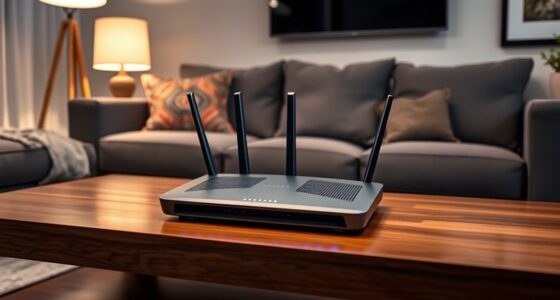A smart thermostat works by using sensors to monitor your home’s temperature, motion, and occupancy. It connects to your Wi-Fi, allowing you to control it remotely via apps or voice commands. It learns your daily routines and preferences through algorithms that analyze your habits, then adjusts heating and cooling automatically for comfort and efficiency. By optimizing settings and monitoring energy use, it helps save money. To discover more about its features and how it’s changing home climate control, keep exploring.
Key Takeaways
- It uses sensors and algorithms to monitor room temperature and detect presence for automatic adjustments.
- Connects to Wi-Fi for remote control and software updates via apps or voice assistants.
- Learns user habits and preferences over time to optimize heating and cooling schedules.
- Integrates with other smart home devices for seamless automation and energy efficiency.
- Secures data through encryption and authentication to protect user privacy and system integrity.
Understanding the Core Components of a Smart Thermostat

To understand how a smart thermostat functions, it’s essential to know its core components. These include a user interface, such as a touchscreen or app, which allows you to customize settings easily. The device also contains a microcontroller that processes your inputs and manages operations efficiently. Its built-in Wi-Fi module connects the thermostat to your home network, enabling remote control and updates. This connectivity plays a crucial role in boosting energy efficiency by optimizing heating and cooling schedules based on your habits. User customization is at the heart of a smart thermostat’s design, giving you the power to set preferences, create schedules, and adjust temperature remotely. Additionally, understanding home automation technology helps in comprehending how smart thermostats integrate seamlessly with other smart devices in your home. Together, these core components work seamlessly to make your home more comfortable and energy-efficient.
Sensors and Data Collection: The Device’s Eyes and Ears
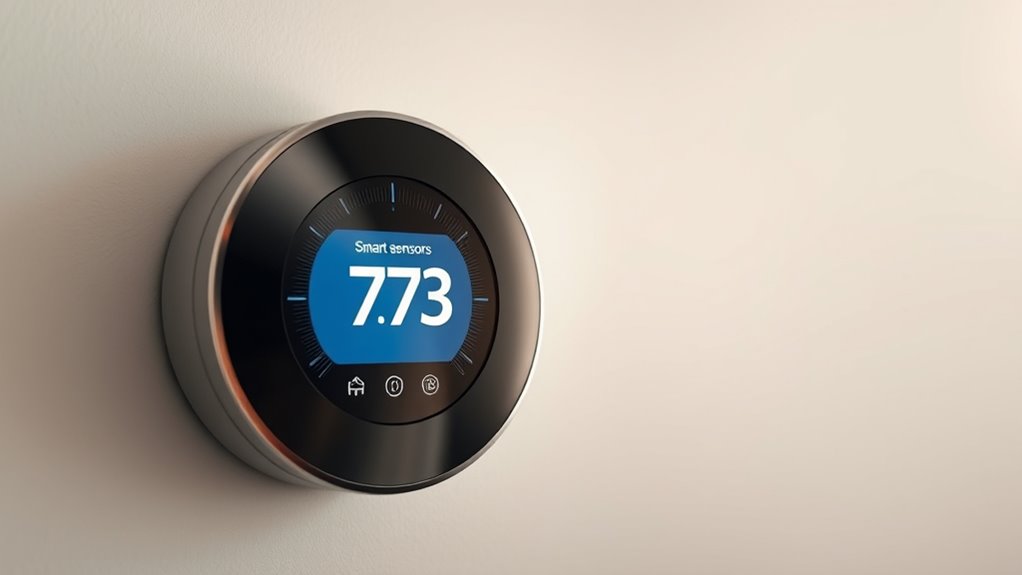
Sensors and data collection serve as the smart thermostat’s eyes and ears, constantly monitoring your home to gather essential information. Temperature sensors detect the current room temperature, while motion sensors determine if anyone is present, helping the device adjust settings accordingly. To guarantee accuracy, sensor calibration is regularly maintained, preventing false readings and optimizing performance. Data collection also involves securely transmitting this information to the thermostat’s processor, often protected by data encryption to keep your privacy safe. These sensors work together to provide real-time feedback, allowing the thermostat to make informed decisions about heating and cooling. By precisely capturing environmental data, the device can efficiently maintain your preferred comfort level while conserving energy. Additionally, understanding AI in Education helps improve how these smart devices adapt to user needs and enhance overall performance.
Connectivity and Integration With Smart Home Systems
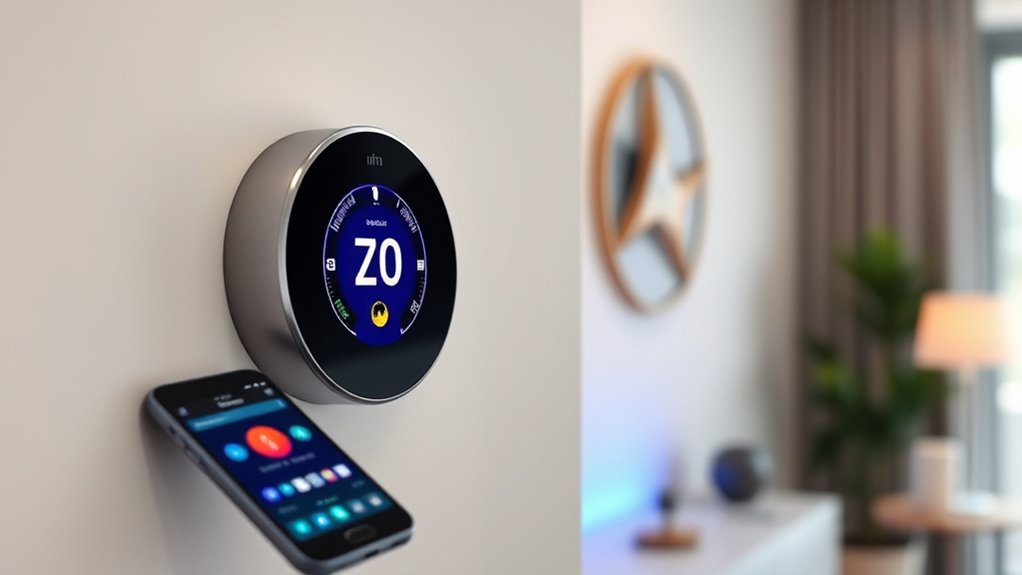
Your smart thermostat connects easily with other devices, ensuring compatibility across various brands and systems. With centralized control platforms, you can manage all your smart home gadgets from a single app or interface. This integration makes your home more responsive and simplifies how you adjust settings and create routines. Additionally, many smart thermostats support mobile responsiveness, allowing you to control your system seamlessly from smartphones and tablets.
Seamless Device Compatibility
Seamless device compatibility is essential for smart thermostats to function effectively within modern smart home systems. You want your thermostat to connect effortlessly with your existing devices, ensuring smooth operation. Many smart thermostats support various brands, thanks to broad compatibility, but check for device branding to confirm. Compatibility also depends on aesthetic design—matching your home’s decor and user interface. When devices integrate well, you get a cohesive tech environment that’s easy to control. Ensuring compatibility range is comprehensive helps prevent issues with device interoperability and enhances user experience.
Centralized Control Platforms
Centralized control platforms serve as the hub that connects your smart thermostat to your entire home automation system. They enable you to control everything from a single app or voice commands, simplifying management. With this integration, you can easily adjust your thermostat alongside lights, security, and other devices. These platforms often support voice assistants like Alexa or Google Assistant, letting you change settings hands-free. They also facilitate energy audits, providing detailed reports on your energy use and suggesting ways to optimize efficiency. By linking all your smart devices, centralized control platforms help you save energy, improve comfort, and streamline your home management. This seamless connectivity ensures your smart thermostat works harmoniously within your smart home ecosystem, making automation more intuitive and efficient. Additionally, predictive modeling can be used within these platforms to analyze usage patterns and proactively suggest adjustments for optimal energy savings.
How Algorithms Learn Your Habits and Preferences
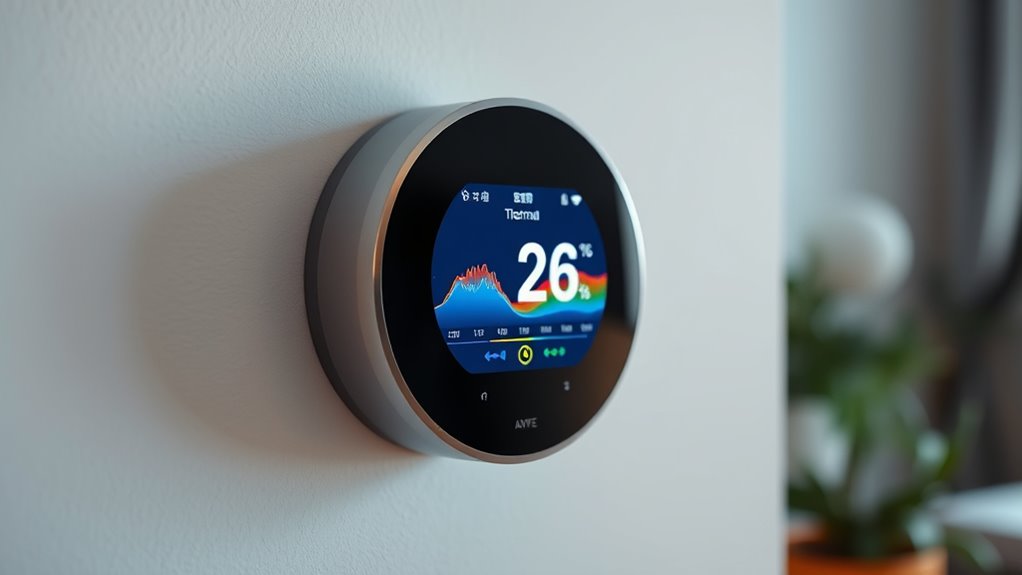
Algorithms in smart thermostats analyze your daily routines and temperature adjustments to identify patterns. They use machine learning to interpret your behaviors and create user profiles that reflect your preferences. As you go about your day, the thermostat tracks when you typically raise or lower the temperature, recognizing trends over time. This data helps the device predict when you’ll want the heating or cooling to activate, ensuring comfort without manual input. Your habits become embedded in the system, allowing it to automatically adjust settings based on your schedule and preferences. The more you interact with your thermostat, the better it learns your habits, making your home environment more personalized and energy-efficient. This process combines real-time data with machine learning to optimize comfort seamlessly. Continuous Improvement through data analysis allows the system to adapt to changing routines for optimal efficiency.
Temperature Control: Adjusting Settings for Comfort and Efficiency
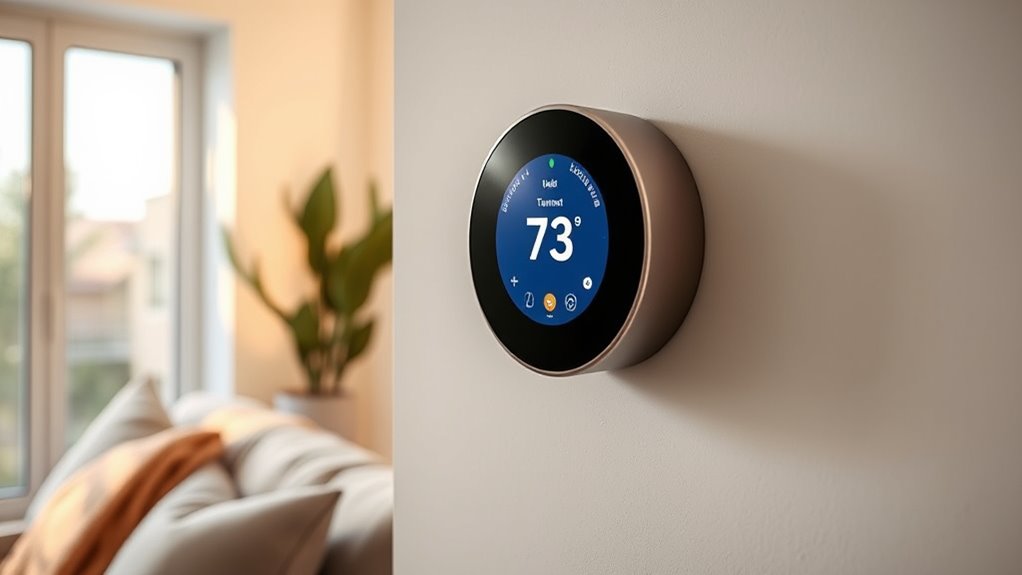
You can easily set your preferred temperatures to stay comfortable and save energy. Smart thermostats use adaptive learning algorithms to automatically adjust these settings based on your habits. By optimizing your schedule, they help you reduce energy use without sacrificing comfort. Additionally, many models can be programmed to operate during specific hours, similar to grocery store hours, ensuring efficient energy management around your daily routine.
Setting Temperature Preferences
Adjusting your smart thermostat’s temperature preferences allows you to create a comfortable environment while also saving energy. By customizing your settings, you control how your heating or cooling system operates, directly impacting energy consumption. You can set specific temperatures for different times of the day or week, tailoring the environment to your routines. User customization makes it easy to find a balance between comfort and efficiency, ensuring your home stays cozy without wasting energy. Many smart thermostats also let you modify preferences remotely via smartphone, giving you control wherever you are. This flexibility helps you avoid unnecessary heating or cooling, reducing overall energy use. Fine-tuning your temperature preferences ensures your system works efficiently while meeting your comfort needs. Understanding the importance of energy efficiency can help you optimize your thermostat settings for long-term savings.
Adaptive Learning Algorithms
Since smart thermostats learn from your habits, they can automatically optimize temperature settings to enhance comfort and save energy. They use machine learning and adaptive algorithms to analyze your behavior patterns, such as when you wake up or return home. These algorithms adjust your thermostat settings based on your daily routines, ensuring your home is comfortable when you need it and energy-efficient when you don’t. Over time, the system recognizes changes in your schedule and preferences, refining its adjustments for better accuracy. This continuous learning process allows your thermostat to respond intelligently, reducing energy waste without sacrificing comfort. Additionally, personalized climate control can be achieved as the thermostat adapts to your unique lifestyle and environmental factors. By leveraging adaptive algorithms, smart thermostats create a personalized climate control experience tailored to your lifestyle.
Energy Saving Strategies
Have you ever wondered how smart thermostats help cut energy costs while maintaining comfort? They do this by using energy-saving strategies like adjusting temperature settings based on your habits and preferences. With user customization, you can set schedules that optimize energy efficiency without sacrificing comfort, such as lowering the temperature when you’re away or asleep. Many smart thermostats learn from your behaviors, automatically adjusting to save energy during periods of low activity. Additionally, they often include features like geofencing, which detects when you’re leaving or returning home to modify temperatures accordingly. By fine-tuning your heating and cooling patterns, you conserve energy, reduce utility bills, and help the environment—all while keeping your home comfortable. Incorporating vetted settings ensures safety and optimal performance while maximizing savings.
Remote Access and User Interaction
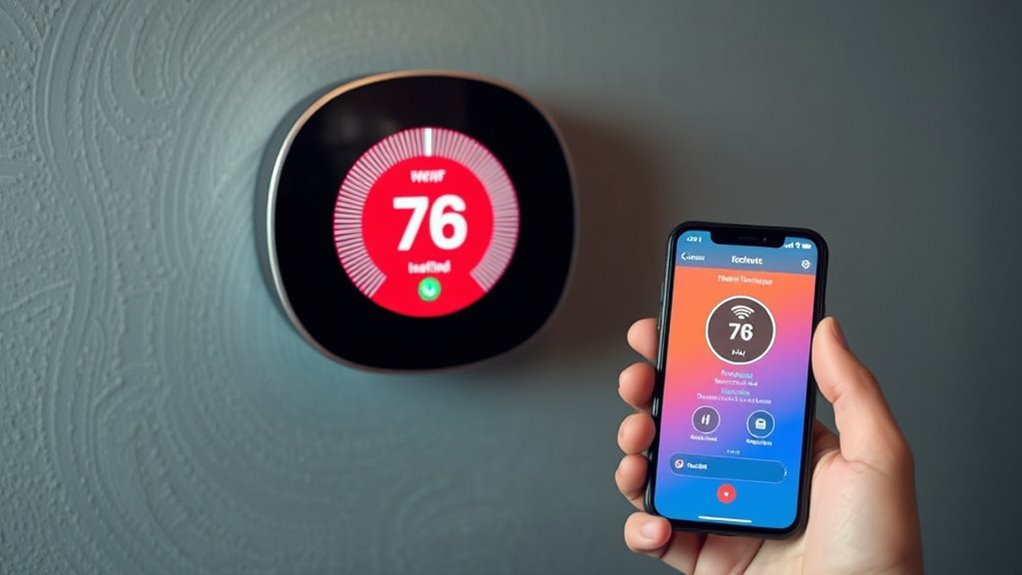
Ever wondered how you can control your thermostat from anywhere? With a smart thermostat, remote access facilitates it. Using your smartphone or tablet, you can adjust the temperature, set schedules, or turn the system on or off, no matter where you are. User interaction is seamless, thanks to intuitive apps and web interfaces. You can also give voice commands if your device supports smart assistants like Alexa or Google Assistant—simply speak your request, and your thermostat responds. Of course, you can still make manual adjustments directly on the device if needed. This flexibility ensures you stay comfortable and in control, whether you’re at home or away. The combination of remote access and user-friendly controls makes managing your home’s climate effortless.
Energy Monitoring and Cost Savings Features
Smart thermostats actively track your energy use, helping you identify patterns and areas where you can save. By monitoring your energy consumption in real-time, they provide insights into when and how you use heating or cooling. This data allows you to make informed adjustments, reducing unnecessary energy use and lowering your utility bills. Many models offer detailed reports and analytics, so you can see exactly where your savings come from. Additionally, some thermostats suggest optimized schedules or automatically adjust settings based on your habits, further enhancing cost reduction. With these features, you gain better control over your energy expenses, making your home more efficient. Over time, this proactive monitoring translates into significant savings while maintaining comfort.
Security and Privacy Considerations
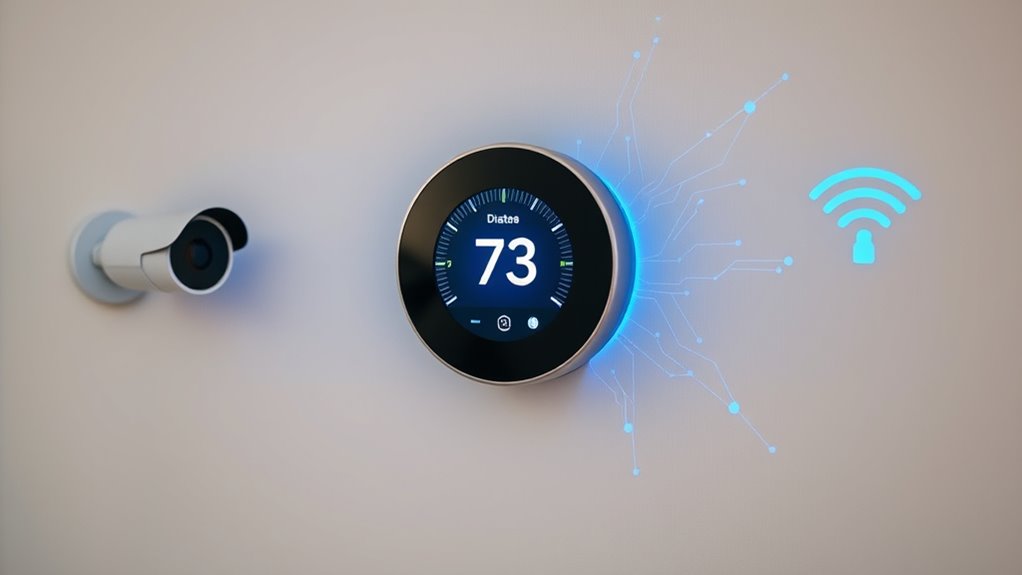
While smart thermostats offer convenience and energy savings, they also raise important security and privacy concerns. Your personal data, including usage patterns and schedules, can be vulnerable if not properly protected. Hackers could access this information or even manipulate your device, risking privacy breaches. To mitigate these risks, manufacturers use data encryption to secure communication between your thermostat and the cloud. Be cautious about sharing your data and ensure your Wi-Fi network is secure.
| Concern | Mitigation |
|---|---|
| Privacy concerns | Use strong, unique passwords |
| Data encryption | Verify that your device employs data encryption |
| Unauthorized access | Enable two-factor authentication |
| Data sharing | Review privacy policies |
| Firmware updates | Keep your device updated for security patches |
Future Trends and Advancements in Smart Thermostat Technology

Advancements in smart thermostat technology are poised to revolutionize how you manage home climate control by integrating more sophisticated features and seamless connectivity. Future trends focus on enhancing user experience through voice recognition, allowing you to control your system hands-free and effortlessly. Personalized settings will become more intuitive, adapting to your routines and preferences for ideal comfort. Expect smarter learning algorithms that adjust temperatures automatically based on your behavior and environmental factors. Key developments include:
- Improved voice recognition accuracy for natural, multi-command interactions
- Enhanced user personalization, tailoring settings to individual habits
- Greater integration with other smart home devices for unified control
These innovations will make your smart thermostat more responsive, intuitive, and efficient, aligning your comfort with your daily life seamlessly.
Frequently Asked Questions
Can Smart Thermostats Function Without Wi-Fi Connectivity?
Smart thermostats generally need Wi-Fi to maximize energy efficiency and user convenience, but some models can operate offline for basic functions. Without Wi-Fi, you’ll still be able to set schedules manually and control your heating or cooling locally. However, you’ll miss out on remote access and automatic adjustments. To guarantee ideal energy savings and convenience, it’s best to keep your smart thermostat connected, but limited offline use is possible for essential control.
How Do Smart Thermostats Handle Power Outages?
Ever wondered what happens during a power outage? Your smart thermostat’s backup power keeps it running long enough to maintain your comfort and save your settings. It stores essential data and firmware updates, so you won’t lose your customized schedules. When power returns, it seamlessly resumes operation. Backup power options like batteries or integration with your home’s power system guarantee your smart thermostat stays smart, even when the lights go out.
Are Smart Thermostats Compatible With All HVAC Systems?
Not all smart thermostats are compatible with every HVAC system. You need to check your system’s type and wiring before choosing one, ensuring it offers energy efficiency and user customization. Some models work better with traditional systems, while others are designed for more advanced setups like multi-stage or heat pump systems. Always verify compatibility to maximize your smart thermostat’s benefits, including energy savings and personalized comfort.
What Safety Features Do Smart Thermostats Include?
Smart thermostats include safety features like humidity control to prevent mold growth and maintain comfort. They often have voice command features, allowing you to adjust settings easily and avoid manual errors. Some models also detect unusual temperature fluctuations or system malfunctions, alerting you to potential issues. These safety features help safeguard your home and ensure your HVAC system runs efficiently, giving you peace of mind and better control over your environment.
How Do Smart Thermostats Impact Home Insurance Policies?
Imagine your smart thermostat detects a fire risk and automatically lowers the temperature, reducing damage, and potentially lowering your home insurance premium. These devices boost your home’s safety, leading insurers to see fewer risks, which can improve your policy terms. Plus, they promote energy savings and user convenience by optimizing heating and cooling, making your home safer and more efficient—beneficial for both your wallet and peace of mind.
Conclusion
Now you know how a smart thermostat works, how it learns your habits, how it connects to your home, and how it saves energy. You understand its sensors, algorithms, and user controls. You see its benefits, from comfort to cost savings, and recognize the importance of security and privacy. With this knowledge, you’re better equipped to make smarter choices, optimize your home’s climate, and embrace the future of comfortable, efficient living.
